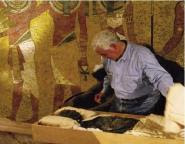
The men and women were piled onto a metal flatbed and stripped naked, some with nothing but clear numbered plastic bags over their heads, and some with no heads at all. Their limbs were contorted, their toes broken, and bits of their ears and eyelashes were missing. Stray upper torsos were strewn next to a sampling of dismembered legs, some discolored, others with holes in them, and a select few still curiously standing in an upright position.
Behind the flatbed were a sea of cardboard boxes and piles of oversized bubble wrap folded neatly on the floor. A sign on a nearby cabinet read: "Adel Rootstein: We're only human, the mannequins are the perfect ones."
Representative of a human ideal, mannequins are “the perfect ones” because in order to incite the desire to buy, they must project an image that consumers yearn to emulate. As beauty ideals, trends, and values are in constant flux, however, these fiberglass renderings of humans are forever re-synchronizing to the frequency of zeitgeist.
Mannequins didn’t always have nipples, for instance. There were no practical or commercial reasons for them to have any until the 1970’s when the women’s liberation movement popularized bra-less tops that required more realistic breasts to showcase in the windows. The same goes for the long, shapely legs that are now seen on mannequins; in the days of ankle skirts, mannequin legs were no more ornate than shower rods. It wasn’t until the arrival of the mini in the 1980’s that mannequin makers toned calves and thighs so that the skirt’s many virtues could be appropriately showcased...
This is the beginning of a 3,000 word feature that I'm currently working on. If it's worthy of posting when I finish, I'll link to the final text.
















































